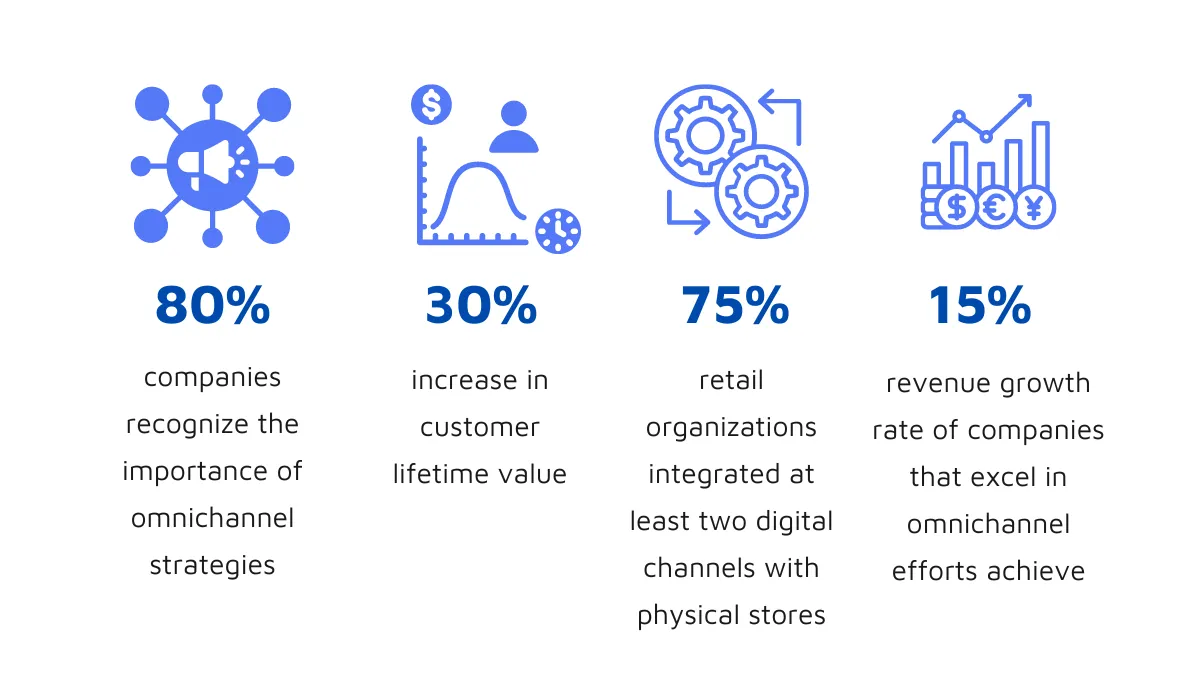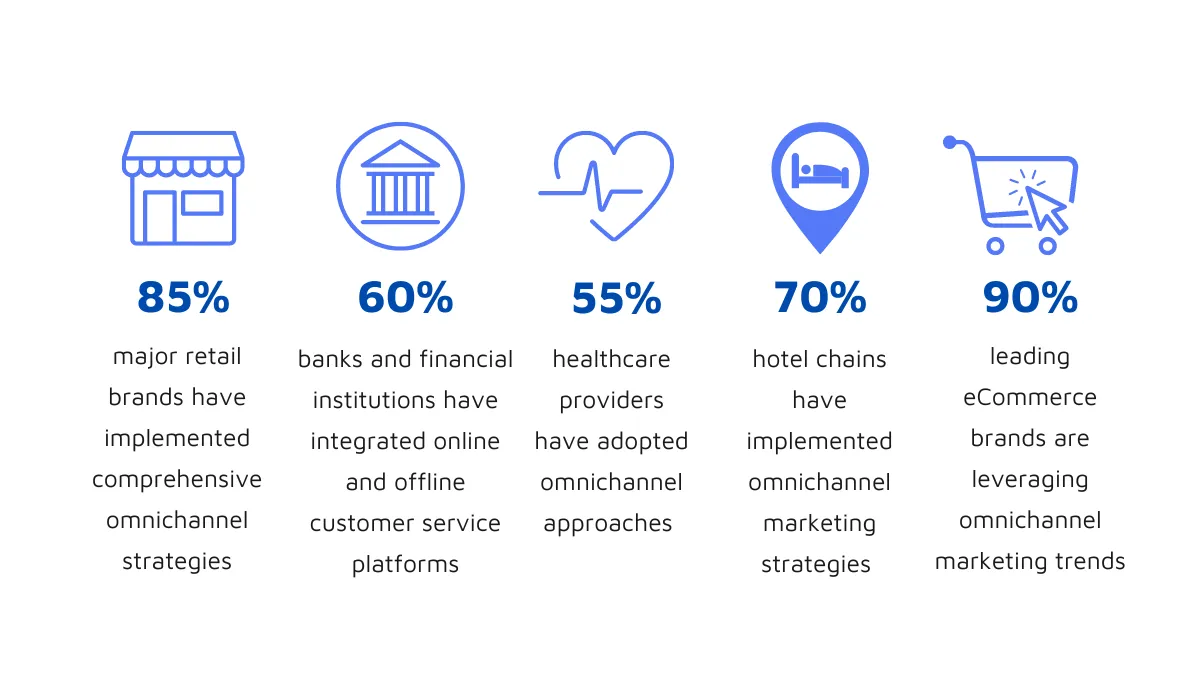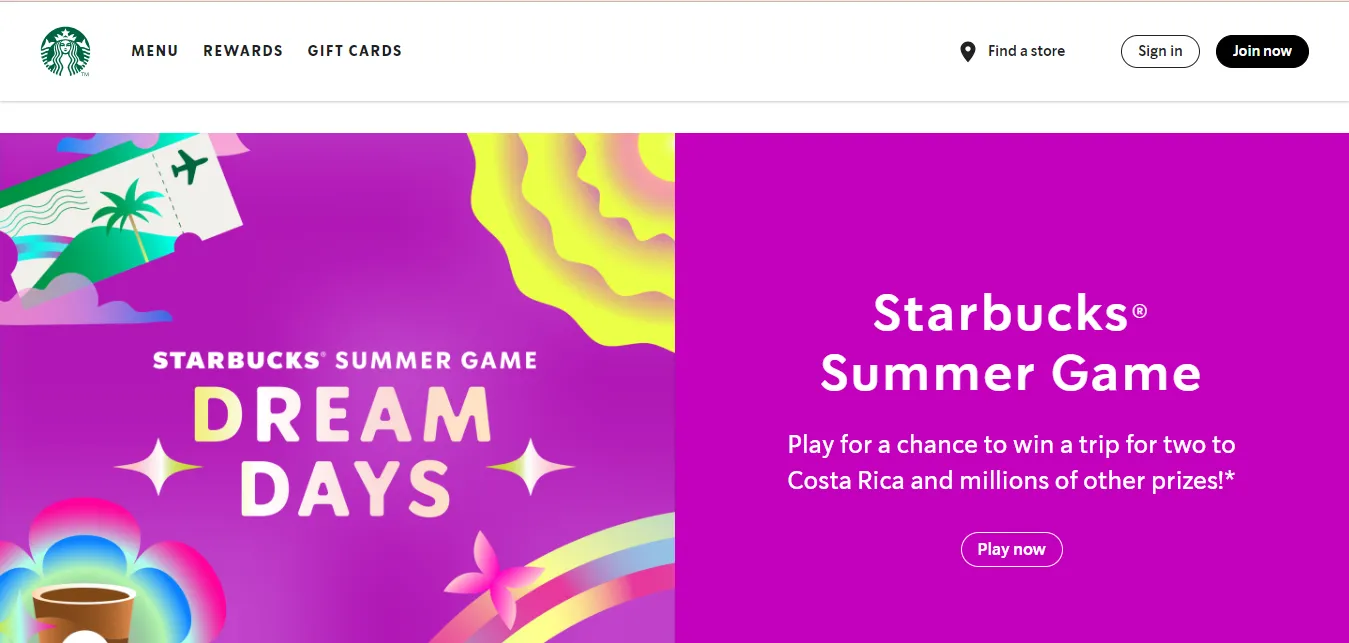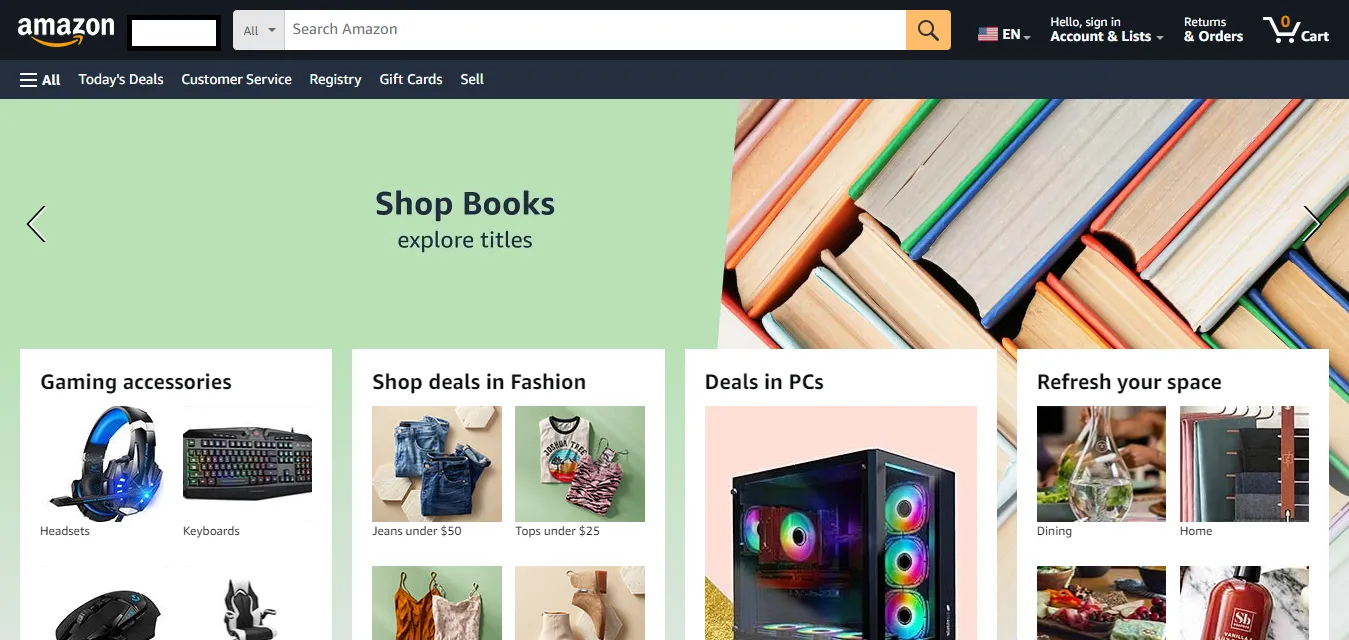As we delve deeper into the world of omnichannel marketing trends, we will explore the current state of this marketing strategy, emerging trends shaping the industry, and the challenges businesses face in implementing omnichannel approaches. Additionally, we will examine real-world case studies of successful omnichannel strategies and offer a glimpse into the future of this dynamic marketing landscape.
Understanding and adapting to these omnichannel marketing trends is essential for businesses aiming to deliver exceptional customer experiences and achieve long-term success in today’s competitive market.
Table of Contents
Current State of Omnichannel Marketing
The current state of omnichannel marketing reveals a landscape where businesses across various industries are increasingly adopting integrated strategies to meet evolving consumer demands. By analyzing adoption rates and key statistics, we can gain insights into how omnichannel marketing trends are shaping the way companies engage with their customers and enhance their overall experience.
Adoption Rate and Statistics
Understanding the current state of omnichannel marketing is essential to grasp the direction in which businesses are moving to meet consumer expectations. The adoption rate and statistics of omnichannel marketing trends provide a clear picture of how widespread and impactful this approach has become across various industries.
Current Statistics on Omnichannel Adoption
In recent years, omnichannel marketing has transitioned from being a competitive advantage to a business necessity. According to a 2023 report by Forrester, over 80% of companies now recognize the importance of implementing omnichannel strategies. This widespread recognition is driven by the increasing demand for seamless and personalized customer experiences. The report also highlights that businesses adopting omnichannel marketing trends see a 30% increase in customer lifetime value compared to those sticking with traditional single-channel approaches.

A study by Gartner reveals that nearly 75% of retail organizations have integrated at least two or more digital channels with their physical stores. This integration is pivotal as it allows customers to experience a unified journey, whether they are shopping online, through a mobile app, or in a brick-and-mortar store. Moreover, companies that excel in their omnichannel efforts achieve a year-over-year revenue growth rate of 15%, compared to the 5% growth rate of those that do not adopt such strategies.
Industry-Specific Adoption Rates
While the overall adoption of omnichannel marketing trends is significant, it is important to note that the extent of adoption varies across different industries. The retail industry, for instance, has been at the forefront of embracing omnichannel marketing. A survey conducted by eMarketer in 2022 found that 85% of major retail brands have implemented comprehensive omnichannel strategies. Retailers like Walmart and Target have been pioneers in offering services such as buy online, pick up in-store (BOPIS) and seamless inventory visibility across all channels.
In the financial services sector, omnichannel marketing trends are also gaining traction. Approximately 60% of banks and financial institutions have integrated their online and offline customer service platforms to provide a cohesive banking experience. Innovations such as mobile banking apps, online customer support, and personalized financial advice have become standard offerings. For example, Bank of America has successfully created an omnichannel experience by linking its mobile app with physical branches, ATMs, and online banking services.

The healthcare industry is another area where omnichannel marketing trends are making significant inroads. Around 55% of healthcare providers have adopted omnichannel approaches to improve patient engagement and streamline operations. This includes the integration of telehealth services, online appointment scheduling, and electronic health records that can be accessed across various platforms. Leading healthcare organizations like Kaiser Permanente are using omnichannel strategies to enhance patient care and communication.
In the hospitality industry, approximately 70% of major hotel chains have implemented omnichannel marketing strategies to enhance guest experiences. This includes the use of mobile apps for check-in and room selection, personalized marketing through email and social media, and the integration of guest preferences across all touchpoints. Marriott International, for example, has successfully utilized omnichannel marketing trends to create a seamless and personalized experience for its guests, from booking to check-out.
The adoption rates in the eCommerce sector are also notable. About 90% of leading eCommerce brands are leveraging omnichannel marketing trends to enhance customer experiences. This involves the integration of various digital touchpoints, such as websites, mobile apps, social media, and even physical pop-up stores. Amazon is a prime example of an eCommerce giant that has mastered the art of omnichannel marketing by offering features like Amazon Prime, Alexa voice shopping, and Amazon Go stores, which combine digital convenience with physical retail.
Key Drivers of Omnichannel Marketing
The rise of omnichannel marketing trends can be attributed to several key drivers that have reshaped how businesses operate and interact with consumers. Understanding these drivers is crucial for comprehending why omnichannel strategies have become essential in today’s market. The primary drivers include technological advancements, shifting consumer expectations, and a competitive landscape that necessitates innovative approaches to marketing.
Technological Advancements
Technological advancements have been at the forefront of driving omnichannel marketing trends. The rapid evolution of technology has provided businesses with the tools and platforms needed to create seamless and integrated customer experiences across various channels.
- Big Data and Analytics: The ability to collect and analyze vast amounts of customer data has revolutionized how businesses understand and engage with their audience. Advanced analytics tools allow companies to gain deep insights into customer behaviors, preferences, and purchasing patterns. By leveraging these insights, businesses can tailor their marketing efforts to provide highly personalized experiences, thereby enhancing customer satisfaction and loyalty.
- Artificial Intelligence and Machine Learning: AI and machine learning are pivotal in enabling omnichannel marketing trends. These technologies facilitate the automation of marketing processes, predictive analytics, and personalized content delivery. For instance, AI-powered chatbots can provide instant customer support across multiple platforms, ensuring a consistent and efficient service experience. Machine learning algorithms can analyze customer data to predict future behaviors, allowing businesses to proactively address customer needs and improve retention rates.
- Integration Platforms: Integration platforms that connect various digital and physical channels are essential for omnichannel marketing. Solutions such as customer relationship management (CRM) systems, enterprise resource planning (ERP) systems, and unified commerce platforms enable businesses to manage customer interactions and transactions in a centralized manner. This integration ensures that customer data is consistent and accessible across all touchpoints, facilitating a seamless customer journey.
- Mobile Technology: The proliferation of smartphones and mobile devices has significantly influenced omnichannel marketing trends. Mobile technology enables consumers to interact with brands anytime and anywhere, making it crucial for businesses to optimize their mobile presence. Mobile apps, responsive websites, and mobile payment solutions are integral components of a successful omnichannel strategy. These tools allow customers to transition smoothly between online and offline interactions, enhancing their overall experience.
Consumer Expectations
As technology advances, so do consumer expectations. Modern consumers are more informed, connected, and demanding than ever before. Meeting these heightened expectations is a critical driver of omnichannel marketing trends.
- Demand for Seamless Experiences: Consumers expect a frictionless experience when interacting with brands, regardless of the channel. They want to be able to start a transaction on one platform and complete it on another without any disruption. For example, a customer might research a product on a retailer’s website, check reviews on social media, and then purchase the product in-store. Businesses that fail to provide a seamless experience risk losing customers to competitors who can meet these expectations.
- Personalization: Personalization has become a key expectation among consumers. They want brands to understand their individual preferences and deliver tailored content and offers. Omnichannel marketing trends emphasize the importance of using customer data to create personalized experiences. This includes personalized email marketing, product recommendations, and targeted advertising. Personalization not only improves customer satisfaction but also drives higher conversion rates and brand loyalty.
- Instant Gratification: In the age of instant information, consumers expect quick responses and immediate gratification. This expectation extends to their interactions with brands. Businesses must be able to provide real-time support and timely updates across all channels. For example, providing instant customer support via chatbots or live chat on websites and social media platforms can significantly enhance the customer experience. Additionally, offering fast and reliable delivery options is crucial for meeting consumer demands.
Competitive Landscape
The competitive landscape is another significant driver of omnichannel marketing trends. In a highly competitive market, businesses must differentiate themselves by offering superior customer experiences.
- Market Saturation: Many industries are experiencing market saturation, where numerous brands offer similar products and services. In such an environment, standing out becomes challenging. Omnichannel marketing provides a competitive edge by enabling businesses to create unique and memorable customer experiences. Companies that effectively implement omnichannel strategies can differentiate themselves by offering convenience, personalization, and consistency across all touchpoints.
- Customer Retention: Retaining customers is more cost-effective than acquiring new ones. Therefore, businesses are increasingly focusing on omnichannel marketing trends to enhance customer retention. By providing a seamless and personalized experience, companies can foster stronger relationships with their customers. Loyalty programs, personalized offers, and consistent communication across channels help build customer loyalty and reduce churn rates.
- Brand Loyalty: In today’s competitive landscape, building brand loyalty is paramount. Omnichannel marketing trends emphasize the importance of creating a cohesive brand experience that resonates with customers. Brands that can maintain consistent messaging and deliver on their promises across all channels are more likely to cultivate loyal customers. For example, a consistent brand voice and visual identity across social media, email marketing, and in-store experiences reinforce brand recognition and trust.
- Innovative Competitors: The presence of innovative competitors in the market drives businesses to adopt omnichannel marketing trends. Companies that are early adopters of new technologies and marketing strategies set the standard for others to follow. Businesses must stay abreast of industry trends and continuously innovate to remain competitive. This includes adopting new technologies, exploring emerging channels, and refining existing processes to enhance the customer experience.
In conclusion, the key drivers of omnichannel marketing trends — technological advancements, shifting consumer expectations, and a competitive landscape — are shaping the future of how businesses engage with their customers. By understanding and leveraging these drivers, companies can create seamless, personalized, and memorable experiences that not only meet but exceed customer expectations. As the market continues to evolve, the importance of staying ahead of omnichannel marketing trends will only grow, making it essential for businesses to continuously adapt and innovate.
Emerging Trends in Omnichannel Marketing
In the rapidly evolving landscape of digital commerce, emerging trends in omnichannel marketing are revolutionizing how businesses connect with consumers. From integrating advanced technologies like AI and AR to leveraging the power of social media and influencer marketing, these trends are reshaping consumer expectations and driving the need for seamless, personalized experiences across all touchpoints. Exploring these trends provides invaluable insights into the future of customer engagement and marketing strategy.
Omnichannel marketing strategies are vital as they create a seamless customer experience across multiple channels, enhancing customer satisfaction and loyalty. By integrating various touchpoints, businesses can gather comprehensive data, allowing for personalized and targeted marketing efforts.
Integration of AI and Machine Learning
One of the most transformative forces driving omnichannel marketing trends today is the integration of artificial intelligence (AI) and machine learning (ML). These advanced technologies are reshaping how businesses interact with their customers, enabling more personalized and efficient marketing strategies.

In this section, we will explore how AI and machine learning contribute to personalized customer experiences and predictive analytics, two critical components of modern omnichannel marketing trends.
Personalized Customer Experiences
Personalization has become a cornerstone of successful omnichannel marketing strategies. Consumers today expect brands to understand their preferences and deliver tailored content, offers, and interactions. AI and machine learning play a pivotal role in achieving this level of personalization by analyzing vast amounts of data and providing actionable insights.
- Data Collection and Analysis: AI and machine learning technologies enable businesses to collect and analyze data from multiple sources, including websites, mobile apps, social media, and in-store interactions. This data includes information about customer preferences, purchase history, browsing behavior, and more. Machine learning algorithms can process this data to identify patterns and trends that are not immediately apparent through traditional analysis methods.
- Customer Segmentation: One of the key applications of AI in omnichannel marketing trends is customer segmentation. Machine learning algorithms can group customers into distinct segments based on their behaviors and preferences. These segments can be incredibly granular, allowing for highly targeted marketing campaigns. For example, an eCommerce retailer might identify a segment of customers who frequently purchase eco-friendly products and tailor marketing messages specifically for this group.
- Personalized Recommendations: AI-powered recommendation engines are a hallmark of personalized customer experiences in omnichannel marketing trends. These engines use machine learning algorithms to analyze individual customer data and recommend products or services that are most likely to appeal to them. Amazon’s recommendation system is a prime example, where customers receive personalized product suggestions based on their browsing and purchase history. This level of personalization not only enhances the customer experience but also drives higher conversion rates and sales.
- Dynamic Content Personalization: AI and machine learning enable dynamic content personalization, where the content displayed to a customer is tailored in real-time based on their behavior and preferences. For instance, an online clothing retailer might show different homepage banners, product recommendations, and promotional offers to different customers based on their previous interactions with the brand. This dynamic personalization creates a more engaging and relevant experience for each customer, increasing the likelihood of conversion.
- Personalized Customer Support: AI-powered chatbots and virtual assistants are revolutionizing customer support by providing personalized assistance across multiple channels. These AI systems can understand and respond to customer inquiries in real-time, offering tailored solutions based on the customer’s history and preferences. For example, a chatbot on a retailer’s website can assist a customer in finding products, checking order status, and even making purchase recommendations based on the customer’s past interactions. This level of personalized support enhances customer satisfaction and loyalty.
Predictive Analytics
Predictive analytics, powered by AI and machine learning, is another critical aspect of emerging omnichannel marketing trends. Predictive analytics involves using historical data and machine learning models to forecast future outcomes. In the context of omnichannel marketing, predictive analytics can provide valuable insights that help businesses make informed decisions and optimize their marketing strategies.
- Customer Behavior Prediction: Predictive analytics can anticipate future customer behaviors based on past interactions. For example, machine learning models can analyze a customer’s purchase history, browsing behavior, and engagement with marketing campaigns to predict their likelihood of making a future purchase. This information allows businesses to proactively target customers with personalized offers and incentives that are likely to drive conversions.
- Churn Prediction: Customer retention is a critical focus for businesses, and predictive analytics can help identify customers who are at risk of churning. By analyzing patterns in customer behavior, such as declining engagement or decreased purchase frequency, machine learning models can flag customers who are likely to stop doing business with the brand. Businesses can then implement targeted retention strategies, such as personalized offers or loyalty programs, to re-engage these customers and reduce churn rates.
- Demand Forecasting: Accurate demand forecasting is essential for managing inventory and optimizing supply chain operations. Predictive analytics can analyze historical sales data, market trends, and external factors such as seasonality to forecast future demand for products or services. This enables businesses to ensure they have the right products in the right quantities at the right time, reducing the risk of stockouts or overstock situations. Effective demand forecasting is particularly important in retail and eCommerce, where inventory management is crucial for meeting customer expectations.
- Campaign Optimization: Predictive analytics can optimize marketing campaigns by identifying the most effective strategies and channels for reaching target audiences. Machine learning models can analyze data from past campaigns to determine which tactics yielded the highest returns and which segments responded best to specific messages. This insight allows marketers to allocate resources more efficiently and design campaigns that are more likely to achieve their objectives. For example, a company might use predictive analytics to determine the best time to send promotional emails or to identify which social media platforms are most effective for engaging their audience.
- Customer Lifetime Value (CLV) Prediction: Predictive analytics can estimate the potential lifetime value of individual customers based on their past behaviors and interactions with the brand. By identifying high-value customers, businesses can tailor their marketing efforts to maximize the long-term value of these relationships. For instance, companies can offer exclusive rewards or personalized services to high-value customers to encourage repeat purchases and foster loyalty. Understanding CLV also helps businesses prioritize their marketing spend and focus on acquiring and retaining the most profitable customers.
Case Study: Sephora
Sephora, a global leader in beauty retail, has successfully integrated AI and machine learning into its omnichannel marketing strategies, setting a benchmark in omnichannel marketing trends. By leveraging these advanced technologies, Sephora has enhanced personalized customer experiences and predictive analytics, driving higher customer engagement and sales.
One of the key ways Sephora has achieved this is through the meticulous collection and analysis of data from various sources, including website interactions, mobile app usage, social media engagements, and in-store behavior. By analyzing this vast amount of data, Sephora gains deep insights into customer preferences, purchase history, and browsing patterns. Machine learning algorithms process this data to uncover trends and patterns that inform personalized marketing strategies, ensuring that each customer receives content and offers tailored to their unique preferences.
A significant application of AI in Sephora’s strategy is customer segmentation. Using machine learning, Sephora segments its customers into distinct groups based on their behaviors and preferences. These granular segments enable Sephora to launch highly targeted marketing campaigns, effectively reaching customers with messages that resonate with their specific interests. For example, customers identified as frequent buyers of eco-friendly products receive marketing messages highlighting Sephora’s sustainable product lines.

Additionally, Sephora’s AI-powered recommendation engine plays a crucial role in personalizing customer experiences. This engine analyzes individual customer data to suggest products that are most likely to appeal to each shopper. This personalized recommendation system not only enhances the customer experience but also drives higher conversion rates and sales. For instance, customers receive personalized product suggestions based on their browsing and purchase history, much like the highly successful recommendation system used by Amazon.
Sephora also excels in dynamic content personalization, where AI and machine learning allow for real-time tailoring of the content displayed to customers based on their behavior and preferences. This dynamic approach ensures that each customer’s interaction with Sephora, whether online or in-store, feels uniquely relevant and engaging. For example, different homepage banners, product recommendations, and promotional offers are shown to different customers based on their previous interactions with the brand.
Moreover, Sephora utilizes AI-powered chatbots and virtual assistants to provide personalized customer support across multiple channels. These AI systems offer real-time assistance, understanding and responding to customer inquiries based on the customer’s history and preferences. This level of personalized support significantly enhances customer satisfaction and loyalty.
In terms of predictive analytics, Sephora has implemented AI and machine learning to forecast future customer behaviors and optimize their marketing strategies. By analyzing historical data, Sephora can anticipate customer needs and preferences, proactively targeting customers with personalized offers and incentives that drive conversions. Predictive analytics also helps Sephora in churn prediction, identifying customers at risk of leaving and enabling the company to implement targeted retention strategies.
Sephora’s success in integrating AI and machine learning into its omnichannel marketing strategy exemplifies the powerful impact of these technologies on modern marketing trends. By focusing on personalized customer experiences and leveraging predictive analytics, Sephora has set a high standard in the realm of omnichannel marketing, continually engaging and delighting its customers while driving business growth.
Enhanced Mobile Experiences
In the realm of omnichannel marketing trends, mobile experiences have emerged as a crucial component. With the ubiquity of smartphones and the increasing reliance on mobile devices for everyday tasks, businesses must prioritize mobile integration to create seamless and engaging customer journeys. Two significant aspects of this integration are mobile app integration and mobile payment solutions. Both play vital roles in enhancing the overall customer experience and driving the success of omnichannel marketing strategies.
Mobile App Integration
Mobile apps have become an integral part of the customer experience, serving as a direct channel for interaction between brands and consumers. Effective mobile app integration is a key trend in omnichannel marketing, providing numerous benefits that enhance the customer journey.
- Seamless User Experience: Mobile apps offer a more streamlined and personalized user experience compared to mobile websites. They are designed to be fast, intuitive, and user-friendly, allowing customers to navigate and complete tasks with ease. By integrating mobile apps into their omnichannel marketing strategies, businesses can provide a consistent experience across all touchpoints. For example, a retailer’s app might allow customers to browse products, check availability, and make purchases, all while syncing with their online and in-store experiences.
- Personalized Interactions: One of the hallmarks of successful omnichannel marketing trends is the ability to deliver personalized interactions. Mobile apps enable businesses to collect and analyze user data to tailor content and recommendations to individual preferences. Push notifications, for instance, can be used to send personalized offers and updates based on a user’s browsing history and purchase behavior. This level of personalization increases engagement and encourages repeat visits.
- Integration with Other Channels: Mobile apps serve as a central hub that connects various channels, creating a cohesive omnichannel experience. For instance, an app can integrate with a brand’s loyalty program, allowing users to earn and redeem points across different platforms. Additionally, features like in-app messaging can provide customer support, bridging the gap between digital and physical interactions. By integrating mobile apps with other channels, businesses ensure that customers have a seamless experience no matter how they choose to interact with the brand.
- Enhanced Shopping Experiences: Mobile apps enhance the shopping experience by offering features that are not easily replicated on other platforms. Augmented reality (AR) is one such feature, allowing customers to visualize products in their own environment before making a purchase. For example, a furniture retailer might offer an AR feature in their app that lets users see how a piece of furniture would look in their home. This interactive and immersive experience can significantly influence purchasing decisions.
- Convenience and Accessibility: Mobile apps provide unparalleled convenience, allowing customers to access information and make purchases anytime, anywhere. Features such as saved payment information, wish lists, and order tracking enhance the overall user experience. Additionally, apps can offer offline functionality, enabling users to browse and add items to their cart even without an internet connection. This level of accessibility is crucial for meeting the demands of today’s always-connected consumers.
Mobile Payment Solutions
Mobile payment solutions are another critical element of enhanced mobile experiences in omnichannel marketing trends. These solutions not only streamline the payment process but also contribute to a seamless and secure customer journey.
- Simplified Checkout Process: One of the primary benefits of mobile payment solutions is the simplification of the checkout process. Traditional payment methods can be cumbersome, often requiring customers to manually enter their payment information. Mobile payment solutions, such as Apple Pay, Google Wallet, and PayPal, allow customers to complete transactions with just a few taps. This reduces friction and cart abandonment rates, leading to higher conversion rates.
- Security and Trust: Security is a top concern for consumers when making online purchases. Mobile payment solutions offer enhanced security features, such as tokenization and biometric authentication, to protect sensitive information. Tokenization replaces card details with a unique identifier, reducing the risk of fraud. Biometric authentication, such as fingerprint or facial recognition, adds an extra layer of security, building trust with customers. By offering secure mobile payment options, businesses can enhance customer confidence and loyalty.
- Integration with Loyalty Programs: Mobile payment solutions can be seamlessly integrated with loyalty programs, providing additional incentives for customers to use these methods. For example, a retailer might offer bonus loyalty points for purchases made using their mobile app’s payment feature. This integration not only encourages the use of mobile payments but also enhances the overall value proposition of the loyalty program. Customers are more likely to engage with the brand when they receive tangible rewards for their transactions.
- Contactless Payments: The rise of contactless payments has been accelerated by the global pandemic, making it a vital aspect of omnichannel marketing trends. Contactless payments offer a fast, safe, and hygienic way for customers to complete transactions, both online and in-store. NFC (Near Field Communication) technology allows customers to simply tap their mobile device on a payment terminal to make a purchase. This technology is particularly beneficial for physical stores, as it reduces the need for physical contact and speeds up the checkout process.
- Cross-Channel Payment Consistency: Consistency across payment channels is essential for a seamless omnichannel experience. Mobile payment solutions ensure that customers can use the same payment methods across different touchpoints, whether they are shopping online, through a mobile app, or in a physical store. This consistency simplifies the customer journey and reduces potential friction points. For example, a customer can save their preferred payment method in their mobile app and use it for both online and in-store purchases, providing a unified experience.
- Integration with Digital Wallets: Digital wallets, such as Apple Wallet and Google Pay, have become increasingly popular as they offer a convenient way to store payment information, loyalty cards, and even tickets. Integrating mobile payment solutions with digital wallets enhances the overall customer experience by providing a single, secure location for all payment-related information. Businesses can leverage this integration to offer seamless payment options and personalized offers directly through the digital wallet, further enhancing customer engagement.
In conclusion, enhanced mobile experiences are a critical component of emerging omnichannel marketing trends. Mobile app integration and mobile payment solutions provide the tools necessary to create seamless, personalized, and secure customer journeys. As mobile technology continues to evolve, businesses must prioritize these elements to stay competitive and meet the ever-increasing expectations of modern consumers.
Case Study: Starbucks
Starbucks has been a leader in adopting and creating omnichannel marketing trends, particularly through its enhanced mobile experiences. The company’s innovative approach to integrating mobile technology into its marketing strategy has set a benchmark for how businesses can leverage mobile apps and payment solutions to create a seamless and engaging customer experience. Founded in 1971, Starbucks has grown into a global coffeehouse chain with thousands of locations worldwide. Known for its premium coffee and customer-centric approach, Starbucks has continually evolved to meet changing consumer expectations. In recent years, the company has focused on enhancing its mobile experiences to drive customer engagement and loyalty.
Starbucks has developed one of the most successful mobile apps in the retail industry, which plays a central role in its omnichannel marketing strategy. The Starbucks app offers a variety of features designed to enhance the customer experience, including mobile ordering, payment options, and loyalty rewards. The app allows customers to browse the menu, customize their orders, and pay directly from their smartphones, creating a seamless and convenient ordering process.

One of the standout features of the Starbucks app is the ability to order ahead. Customers can place their orders through the app and pick them up at their chosen location without waiting in line. This functionality not only saves time but also integrates the online and offline experiences seamlessly. By offering personalized recommendations based on previous orders and preferences, the app ensures that each interaction is tailored to the individual customer, reflecting key omnichannel marketing trends.
Starbucks has been at the forefront of mobile payment adoption, making it easier and faster for customers to complete their transactions. The app supports various payment methods, including Starbucks Cards, credit and debit cards, and digital wallets like Apple Pay and Google Pay. This flexibility ensures that customers can choose their preferred payment method, enhancing convenience and satisfaction.
In addition to simplifying the payment process, Starbucks has integrated its loyalty program, Starbucks Rewards, into the mobile payment system. Customers earn stars for every purchase made through the app, which can be redeemed for free drinks and food items. This integration not only incentivizes app usage but also strengthens customer loyalty by offering tangible rewards for continued engagement.
The Starbucks app has significantly boosted customer engagement by providing a convenient and personalized experience. Features like order ahead and mobile payments have made the purchasing process more efficient, leading to higher customer satisfaction. The app’s personalized recommendations and offers keep customers coming back, driving repeat business and loyalty.
By streamlining the ordering and payment processes, Starbucks has improved operational efficiency in its stores. The order-ahead feature reduces congestion at the counter, allowing baristas to focus on preparing drinks rather than processing payments. This efficiency not only enhances the customer experience but also enables Starbucks to serve more customers quickly, increasing overall sales.Starbucks has reported significant growth in mobile transactions since the introduction of its app. In some markets, mobile orders account for a substantial portion of total sales, demonstrating the app’s effectiveness in driving digital engagement. The success of Starbucks’ mobile strategy highlights the importance of integrating mobile technology into omnichannel marketing trends to meet evolving consumer expectations.
Starbucks has successfully enhanced its mobile experiences to create a seamless and engaging omnichannel marketing strategy. By integrating mobile app functionality with personalized interactions and flexible payment options, Starbucks has set a high standard for customer-centric innovation. The company’s success in leveraging mobile technology reflects the broader trends in omnichannel marketing, emphasizing the importance of convenience, personalization, and integration across all touchpoints.
Unified Commerce Platforms
Unified commerce platforms represent one of the most significant advancements in omnichannel marketing trends, enabling businesses to deliver a seamless and integrated customer experience. Unlike traditional multichannel strategies that often operate in silos, unified commerce platforms provide a centralized system that connects all sales channels, enhancing efficiency, accuracy, and customer satisfaction. This section will delve into two critical components of unified commerce platforms: centralized management systems and real-time inventory tracking.
Centralized Management Systems
Centralized management systems are at the heart of unified commerce platforms, offering a single, cohesive solution for managing various aspects of a business. These systems integrate multiple functions such as sales, inventory, customer data, and order management into one platform, providing a holistic view of the business operations.
- Holistic View of Operations: Centralized management systems consolidate data from all sales channels, including physical stores, eCommerce websites, mobile apps, and social media platforms. This integration provides businesses with a comprehensive view of their operations, enabling better decision-making and strategic planning. For example, a retailer can easily track sales performance across different channels, identify trends, and adjust their marketing strategies accordingly. This unified approach helps eliminate the inefficiencies and inconsistencies often associated with managing separate systems for each channel.
- Enhanced Customer Experience: One of the primary benefits of centralized management systems in the context of omnichannel marketing trends is the ability to enhance the customer experience. By having a single view of the customer, businesses can provide personalized and consistent interactions across all touchpoints. For instance, customer service representatives can access a customer’s purchase history and preferences, regardless of where the purchase was made, to offer tailored support and recommendations. This level of personalization fosters customer loyalty and satisfaction.
- Streamlined Order Management: Centralized management systems streamline the order management process by integrating orders from all channels into a single platform. This integration simplifies the fulfillment process, reduces errors, and ensures timely delivery. For example, a customer might place an order online and choose to pick it up in-store. The centralized system ensures that the order is processed efficiently, and the in-store staff is notified in real-time. This seamless coordination between online and offline channels is a hallmark of effective omnichannel marketing trends.
- Improved Inventory Management: Inventory management is a critical aspect of unified commerce platforms. Centralized management systems provide real-time visibility into inventory levels across all locations, reducing the risk of stockouts and overstock situations. Businesses can optimize their inventory by understanding demand patterns and adjusting their stock levels accordingly. For example, if a particular product is selling quickly online but not in physical stores, the system can trigger a transfer of stock to meet the demand. This dynamic management of inventory ensures that customers can always find the products they need, enhancing their shopping experience.
- Data-Driven Insights: The data collected and consolidated by centralized management systems can be leveraged to gain valuable insights into customer behavior and market trends. Advanced analytics tools can analyze this data to identify opportunities for growth and improvement. For example, a business can use predictive analytics to forecast future demand, plan marketing campaigns, and optimize pricing strategies. By harnessing the power of data, businesses can stay ahead of omnichannel marketing trends and make informed decisions that drive success.
Real-Time Inventory Tracking
Real-time inventory tracking is another essential component of unified commerce platforms, playing a crucial role in omnichannel marketing trends. Using a suitable inventory management system to ensure real-time inventory visibility, preventing stockouts and overselling, and enhancing customer satisfaction across all sales channels. Accurate and up-to-date inventory information is vital for meeting customer expectations and ensuring operational efficiency.
- Accurate Inventory Visibility: Real-time inventory tracking provides businesses with accurate visibility into their stock levels at all times. This visibility extends across all sales channels and locations, including warehouses, distribution centers, and retail stores. Accurate inventory information is essential for fulfilling customer orders promptly and efficiently. For example, if a customer places an order online for in-store pickup, the system can immediately verify the availability of the item and reserve it for the customer. This level of accuracy prevents disappointing customers with out-of-stock notifications and enhances their shopping experience.
- Efficient Fulfillment Processes: Real-time inventory tracking enables businesses to optimize their fulfillment processes by ensuring that they have the right products in the right locations. This optimization reduces the time and cost associated with shipping and handling. For instance, if a customer orders a product that is available at multiple locations, the system can automatically select the nearest location to minimize shipping time and costs. This efficient fulfillment process is a key aspect of successful omnichannel marketing trends, as it enhances customer satisfaction and loyalty.
- Inventory Optimization: Real-time inventory tracking allows businesses to optimize their inventory levels by providing insights into demand patterns and stock movements. By analyzing this data, businesses can make informed decisions about when to reorder products, how much stock to keep on hand, and where to allocate inventory. For example, if a particular product is selling well in one region but not in another, the system can suggest transferring stock to balance inventory levels. This optimization reduces the risk of stockouts and excess inventory, improving overall profitability.
- Reduced Inventory Costs: Maintaining optimal inventory levels is crucial for controlling costs. Real-time inventory tracking helps businesses reduce carrying costs by ensuring that they do not overstock products. It also minimizes the costs associated with stockouts, such as lost sales and expedited shipping. By keeping inventory levels aligned with actual demand, businesses can improve their cash flow and profitability. This cost-efficiency is a significant advantage in the context of omnichannel marketing trends, where margins can be tight, and competition is fierce.
- Enhanced Customer Experience: Real-time inventory tracking directly impacts the customer experience by providing accurate and reliable information about product availability. Customers can check stock levels online before visiting a store, ensuring that the product they want is available. This transparency builds trust and encourages customers to shop with confidence. Additionally, real-time inventory information allows businesses to offer features such as buy online, pick up in-store (BOPIS), and same-day delivery, which are highly valued by customers in today’s fast-paced retail environment.
- Data-Driven Decision Making: The data generated by real-time inventory tracking systems can be used to drive strategic decision-making. Businesses can analyze inventory data to identify trends, forecast demand, and plan promotions. For example, if a particular product category is experiencing high demand, the business can allocate more marketing resources to promote those products. By leveraging real-time inventory data, businesses can stay agile and responsive to market changes, ensuring they remain competitive in the ever-evolving landscape of omnichannel marketing trends.
Case Study: Zara
Zara, the globally recognized fashion retailer, has successfully established unified commerce platforms to enhance its omnichannel marketing strategy, leading the way in omnichannel marketing trends. By integrating centralized management systems and real-time inventory tracking, Zara has created a seamless shopping experience that bridges the gap between its online and offline channels, setting a benchmark for other retailers.
Founded in 1975, Zara has grown into one of the world’s largest fashion retailers, known for its trendy and affordable clothing. The company operates a vast network of physical stores complemented by a robust online presence. Zara’s ability to quickly respond to fashion trends and deliver new products to market has been a key factor in its success. To further enhance its competitive edge, Zara has focused on developing a unified commerce platform that integrates all aspects of its business.
Zara has implemented a centralized management system that integrates sales, inventory, customer data, and order management into a single platform. This system consolidates data from all sales channels, including physical stores, eCommerce websites, and mobile apps, providing a holistic view of the company’s operations. By leveraging this integrated approach, Zara can track sales performance across different channels, identify trends, and make informed decisions to optimize its marketing strategies.

One of the primary benefits of this centralized system is the enhanced customer experience. With a unified view of each customer, Zara can provide personalized and consistent interactions across all touchpoints. For example, customer service representatives can access a customer’s purchase history and preferences, regardless of where the purchase was made, to offer tailored support and recommendations. This level of personalization is a hallmark of effective omnichannel marketing trends and helps foster customer loyalty and satisfaction. Zara has also implemented real-time inventory tracking to ensure accurate and up-to-date inventory information across all locations. This technology provides Zara with accurate visibility into stock levels at all times, extending across warehouses, distribution centers, and retail stores. Accurate inventory information is essential for fulfilling customer orders promptly and efficiently.
For instance, if a customer places an order online for in-store pickup, the system can immediately verify the availability of the item and reserve it for the customer. This level of accuracy prevents disappointing customers with out-of-stock notifications and enhances their shopping experience. Additionally, real-time inventory tracking allows Zara to optimize its fulfillment processes by ensuring that the right products are in the right locations, reducing the time and cost associated with shipping and handling.
The centralized management system and real-time inventory tracking have significantly improved Zara’s operational efficiency. By streamlining the order management process and optimizing inventory levels, Zara can ensure timely delivery and reduce the risk of stockouts and overstock situations. This efficiency not only enhances the customer experience but also improves overall profitability.The seamless integration of online and offline channels has led to higher customer satisfaction. Customers can easily check stock levels online before visiting a store, ensuring that the products they want are available. Features like buy online, pick up in-store (BOPIS) and same-day delivery provide added convenience, aligning with modern omnichannel marketing trends that prioritize customer needs.
The data collected through Zara’s unified commerce platform provides valuable insights into customer behavior and market trends. Advanced analytics tools can analyze this data to identify opportunities for growth and improvement. For example, predictive analytics can forecast future demand, helping Zara plan marketing campaigns and optimize pricing strategies. By successfully integrating unified commerce platforms into its omnichannel marketing strategy, Zara has solidified its position as a market leader in the fashion retail industry. The company’s innovative approach to leveraging technology has set a new standard for customer-centric retailing, demonstrating the importance of embracing omnichannel marketing trends to meet evolving consumer expectations.
Zara’s successful establishment of unified commerce platforms exemplifies how businesses can lead omnichannel marketing trends by integrating centralized management systems and real-time inventory tracking. These initiatives have enhanced operational efficiency, improved customer satisfaction, and provided valuable data-driven insights. As omnichannel marketing trends continue to evolve, Zara’s innovative approach serves as a model for other retailers looking to stay competitive and meet the demands of modern consumers.
Voice Commerce and Smart Assistants
Voice commerce and smart assistants have emerged as transformative forces in the landscape of omnichannel marketing trends. As consumers increasingly rely on voice-activated devices for various tasks, businesses are finding innovative ways to integrate these technologies into their marketing strategies. This section explores two key aspects of this trend: the adoption of voice search and the integration with smart home devices.
Adoption of Voice Search
Voice search has rapidly gained popularity, driven by the convenience and speed it offers. With the rise of smart speakers like Amazon Echo, Google Home, and Apple’s HomePod, as well as voice-activated assistants like Siri, Google Assistant, and Alexa, consumers are now more comfortable using voice commands to search for information, make purchases, and control smart devices. This shift in behavior is a significant driver of current omnichannel marketing trends.
- Increasing Popularity: According to a study by Juniper Research, the number of voice assistants in use is expected to reach 8 billion by 2023. This widespread adoption indicates that voice search is becoming a standard mode of interaction for many consumers. Businesses must adapt to this trend by optimizing their content for voice search to remain competitive. Voice search queries tend to be longer and more conversational compared to text searches, requiring a different approach to search engine optimization (SEO).
- SEO and Content Optimization: To capitalize on the adoption of voice search, businesses need to optimize their content for voice queries. This involves focusing on natural language processing (NLP) and understanding the intent behind voice searches. Long-tail keywords, question-based queries, and conversational phrases should be incorporated into the content strategy. For example, instead of optimizing for the keyword “best pizza in New York,” businesses should consider phrases like “Where can I find the best pizza in New York?” This approach aligns with how consumers typically use voice search.
- Enhanced User Experience: Voice search enhances the user experience by providing quick and hands-free access to information. This convenience is particularly beneficial for consumers who are multitasking or on the go. Businesses can leverage this trend by creating voice-friendly content that answers common customer questions and provides relevant information efficiently. For instance, a restaurant could optimize its content to include voice-searchable details about its menu, hours of operation, and location, making it easier for potential customers to find and engage with the business.
- Personalized Interactions: Voice search technology, powered by AI, enables personalized interactions by understanding the context and preferences of users. Smart assistants can provide tailored recommendations based on previous interactions and known preferences. This level of personalization is a key component of effective omnichannel marketing trends. For example, a smart assistant might suggest nearby restaurants based on a user’s dining history or recommend products that align with their past purchases. Businesses can use this technology to deliver personalized marketing messages and offers, enhancing customer engagement and loyalty.
- Voice Commerce: Voice commerce, or v-commerce, is the next frontier in omnichannel marketing trends. This involves using voice commands to make purchases through smart speakers and voice assistants. According to a report by OC&C Strategy Consultants, voice shopping is expected to reach $40 billion in the U.S. and $5 billion in the U.K. by 2022. To tap into this market, businesses need to ensure their products are available and optimized for voice commerce platforms. This includes integrating with platforms like Amazon Alexa and Google Assistant, enabling seamless voice-based transactions.
Integration with Smart Home Devices
The integration of smart home devices with omnichannel marketing strategies offers new opportunities for businesses to engage with consumers in innovative ways. Smart home devices, including smart speakers, thermostats, lighting systems, and security cameras, are becoming increasingly common in households. Leveraging these devices can enhance the customer experience and drive engagement.
- Interconnected Ecosystems: Smart home devices create an interconnected ecosystem that allows for seamless interaction between different devices and platforms. This integration provides a holistic view of consumer behavior and preferences, enabling businesses to deliver more personalized and contextually relevant experiences. For example, a smart home system might detect when a user is running low on groceries and prompt them to reorder through a voice assistant. This level of integration aligns with the principles of omnichannel marketing trends, ensuring a cohesive and convenient customer journey.
- Enhanced Customer Engagement: Integrating with smart home devices allows businesses to engage with customers in new and innovative ways. For instance, a smart refrigerator can suggest recipes based on the ingredients it detects, and offer the option to purchase missing items through a connected voice assistant. Similarly, a smart speaker can remind users of upcoming appointments, promotions, or product launches, driving engagement and brand loyalty. These interactions create a more immersive and interactive experience for consumers.
- Data Collection and Personalization: Smart home devices generate a wealth of data that can be used to personalize marketing efforts. By analyzing data from various smart devices, businesses can gain insights into consumer preferences, habits, and behaviors. This information can be used to tailor marketing messages and offers to individual customers, enhancing the relevance and effectiveness of marketing campaigns. For example, a smart thermostat might provide insights into a user’s energy consumption patterns, allowing energy companies to offer personalized tips and promotions to help them save on their utility bills.
- Convenience and Automation: The integration of smart home devices with omnichannel marketing strategies enhances convenience and automation for consumers. Voice-activated devices can automate routine tasks, such as reordering household supplies or controlling home environments. Businesses can leverage this automation to provide a seamless and hassle-free shopping experience. For instance, a smart assistant can automatically reorder a favorite product when it detects that supplies are running low, or a smart lighting system can adjust settings based on the user’s preferences and routines. This level of convenience strengthens customer loyalty and satisfaction.
- Voice-Activated Advertising: Voice-activated advertising is an emerging trend that leverages smart home devices to deliver targeted marketing messages. Unlike traditional advertising, voice-activated ads can provide interactive and personalized experiences. For example, a smart speaker might deliver a promotional message about a new product, followed by an option for the user to ask for more information or make a purchase. This interactive format increases engagement and provides a more immersive advertising experience.
- Cross-Channel Consistency: Ensuring consistency across all channels, including smart home devices, is crucial for successful omnichannel marketing trends. Businesses need to maintain a consistent brand voice and messaging across all touchpoints, from websites and mobile apps to voice assistants and smart home devices. This consistency reinforces brand identity and ensures a cohesive customer experience. For example, a customer might receive the same personalized product recommendations on their smart speaker as they do on the retailer’s website, creating a seamless and integrated journey.
In conclusion, voice commerce and smart assistants are driving significant changes in omnichannel marketing trends. The adoption of voice search and the integration with smart home devices offer new opportunities for businesses to engage with consumers, enhance personalization, and streamline the customer journey. By embracing these emerging trends, businesses can stay ahead of the competition and meet the evolving expectations of modern consumers. As voice technology continues to advance, its impact on omnichannel marketing will only grow, making it essential for businesses to integrate these innovations into their strategies.
Case Study: Amazon
Amazon has been at the forefront of leveraging voice commerce and smart assistants to enhance its omnichannel marketing strategies. By integrating these technologies, Amazon has set new benchmarks in omnichannel marketing trends, offering seamless, personalized, and convenient shopping experiences for its customers. Founded in 1994, Amazon has grown into one of the largest eCommerce platforms globally, known for its customer-centric approach and relentless innovation. With the introduction of its voice-activated assistant, Alexa, and a wide range of smart home devices, Amazon has revolutionized the way consumers interact with technology and make purchases, solidifying its leadership in omnichannel marketing trends.
Amazon’s Alexa has become synonymous with voice-activated technology, allowing customers to perform a variety of tasks using simple voice commands. By integrating Alexa with its vast eCommerce platform, Amazon has made it possible for customers to search for products, place orders, track deliveries, and even reorder favorite items effortlessly. This integration exemplifies the latest omnichannel marketing trends by providing a hands-free, efficient, and personalized shopping experience. For example, customers can ask Alexa to add items to their shopping cart, check the status of an order, or set reminders for replenishing household supplies. By streamlining these tasks, Amazon enhances customer convenience and satisfaction.

Additionally, Alexa’s ability to provide personalized recommendations based on previous purchases and browsing history aligns with key omnichannel marketing trends, ensuring that customers receive relevant and tailored Amazon’s integration with smart home devices extends beyond voice commerce, creating a cohesive and interconnected ecosystem. Devices such as the Echo smart speakers, Fire TV, and Ring security cameras work seamlessly together, allowing customers to control various aspects of their homes through voice commands or the Amazon app. This interconnectedness enhances the customer experience by offering convenience and automation in daily tasks. For instance, customers can use Alexa to control their smart home devices, such as adjusting the thermostat, turning on lights, or managing home security systems. These capabilities provide a level of convenience that strengthens customer loyalty and engagement.
Moreover, Amazon’s ability to collect data from these devices allows for better personalization and targeted marketing efforts, which are essential components of modern omnichannel marketing trends. Amazon leverages the data collected from Alexa and smart home devices to deliver highly personalized customer experiences. By analyzing user interactions and preferences, Amazon can tailor product recommendations, promotional offers, and content to meet individual needs. This data-driven approach ensures that each customer interaction is relevant and engaging, reflecting the principles of effective omnichannel marketing trends. For example, if a customer frequently uses Alexa to reorder pet supplies, Amazon can send targeted promotions and recommendations for related products. This level of personalization enhances the shopping experience and encourages repeat purchases, driving customer loyalty and sales growth.
Amazon has also explored the potential of voice-activated advertising, delivering targeted marketing messages through Alexa. This innovative approach allows for interactive and personalized advertising experiences, where customers can ask for more information or make purchases directly through voice commands. Voice-activated ads provide a more engaging and immersive format compared to traditional advertising, aligning with emerging omnichannel marketing trends. For instance, Alexa might inform a user about a new product launch or a special promotion and offer the option to learn more or add the item to their cart. This interactive format not only increases engagement but also provides valuable insights into customer preferences and behaviors, enabling more effective marketing strategies.
Amazon’s integration of voice commerce and smart assistants has significantly increased customer engagement and loyalty. The convenience and personalization offered by Alexa and smart home devices create a more enjoyable and efficient shopping experience, encouraging repeat business and long-term customer relationships. The seamless integration of voice-activated technology and smart home devices has streamlined various operational processes for Amazon. By automating tasks such as order placement, tracking, and customer support, Amazon has improved efficiency and reduced operational costs. This efficiency is a key benefit of adopting advanced omnichannel marketing trends.
Amazon’s innovative use of voice commerce and smart assistants has solidified its dominance in the eCommerce market. The company’s ability to anticipate and meet evolving consumer expectations through cutting-edge technology sets it apart from competitors. By staying ahead of omnichannel marketing trends, Amazon continues to lead the industry and shape the future of retail.
Augmented Reality (AR) and Virtual Reality (VR)
In the dynamic landscape of omnichannel marketing trends, Augmented Reality (AR) and Virtual Reality (VR) are emerging as game-changing technologies that redefine how businesses engage with consumers. These technologies offer immersive and interactive experiences that enhance customer engagement and satisfaction.
This section will explore the application of AR and VR in retail and eCommerce, and how they contribute to enhanced product visualization, driving the next wave of omnichannel marketing trends. Especially, the integration of AR and VR in retail omnichannel is enhancing customer engagement by offering immersive shopping experiences.
AR/VR in Retail and eCommerce
The integration of AR and VR in retail and eCommerce is transforming the shopping experience by bridging the gap between online and offline environments. These technologies provide consumers with innovative ways to explore products and make informed purchasing decisions, significantly enhancing omnichannel marketing strategies.
- Virtual Try-Ons: One of the most popular applications of AR in retail is virtual try-ons. This feature allows customers to virtually try on clothing, accessories, or cosmetics using their smartphone or computer. By overlaying digital images onto real-time video, AR enables consumers to see how products will look on them without having to visit a physical store. For instance, beauty brands like Sephora offer AR-powered apps that allow users to try different makeup products virtually. This not only enhances the shopping experience but also reduces the likelihood of returns, as customers can make more confident purchasing decisions.
- Virtual Showrooms: VR technology is revolutionizing the concept of showrooms by creating immersive virtual spaces where customers can explore products in a realistic 3D environment. Retailers can design virtual showrooms that replicate the experience of walking through a physical store, complete with interactive displays and product demonstrations. For example, car manufacturers like Audi use VR to offer virtual test drives, allowing customers to experience different models and features from the comfort of their homes. This innovative approach to showcasing products aligns with omnichannel marketing trends by providing a seamless and engaging shopping experience.
- Interactive Storefronts: AR and VR can also be used to create interactive storefronts that attract and engage customers. For instance, retailers can use AR to create window displays that come to life when viewed through a smartphone app, offering a dynamic and interactive experience. This technology can be used to showcase new products, promote sales, and create an immersive brand experience. Similarly, VR can be used to create pop-up virtual stores that allow customers to browse and purchase products in a unique and engaging way. These interactive storefronts are a powerful tool for driving foot traffic and increasing brand visibility, reflecting the latest omnichannel marketing trends.
- Enhanced Customer Support: AR and VR can significantly enhance customer support by providing immersive and interactive assistance. For example, AR-powered apps can offer step-by-step visual instructions for assembling products or troubleshooting issues, making it easier for customers to solve problems on their own. VR can be used for virtual customer support, where customers can interact with a virtual assistant in a realistic 3D environment. This level of support not only improves customer satisfaction but also reduces the burden on customer service teams, aligning with the goals of omnichannel marketing trends to provide seamless and efficient customer experiences.
Enhanced Product Visualization
Enhanced product visualization through AR and VR is a critical aspect of omnichannel marketing trends, offering customers a deeper understanding of products and their features. This technology enables businesses to create highly detailed and interactive representations of their products, driving engagement and conversion rates.
- 3D Product Models: AR and VR allow businesses to create detailed 3D models of their products that customers can view and interact with in a virtual environment. These models provide a realistic representation of the product, allowing customers to examine it from all angles and zoom in on specific features. For example, furniture retailers like IKEA use AR to let customers place virtual furniture in their homes, helping them see how it fits and looks in their space. This level of detail and interactivity enhances the shopping experience and helps customers make more informed decisions.
- Virtual Product Demos: VR technology can be used to create virtual product demos that showcase the functionality and features of a product in an engaging way. These demos can provide a hands-on experience, allowing customers to interact with the product and see how it works in a simulated environment. For example, tech companies like Samsung use VR to offer virtual tours of their latest devices, demonstrating their features and capabilities. This immersive experience helps customers understand the value of the product and increases their likelihood of making a purchase.
- AR Product Previews: AR allows customers to preview products in their real-world environment before making a purchase. This technology is particularly useful for products that require fitting or placement, such as furniture, home decor, and accessories. By using a smartphone or tablet, customers can overlay a virtual image of the product onto their surroundings, helping them visualize how it will look and fit. For example, a customer shopping for a new TV can use AR to see how it will look on their wall, ensuring it fits perfectly with their decor. This enhanced visualization reduces uncertainty and boosts confidence in the purchase decision, reflecting the effectiveness of omnichannel marketing trends.
- Interactive Product Manuals: AR can transform traditional product manuals into interactive and engaging experiences. Instead of reading through lengthy instructions, customers can use AR apps to see visual guides and animations that demonstrate how to use or assemble a product. For example, a customer buying a piece of DIY furniture can use an AR app to see step-by-step assembly instructions overlaid on the physical parts. This interactive approach makes it easier for customers to understand and follow the instructions, improving their overall experience and satisfaction.
- Virtual Fitting Rooms: Virtual fitting rooms are a significant advancement in AR technology, allowing customers to try on clothes virtually before making a purchase. These fitting rooms use AR to overlay clothing items onto the customer’s image, providing a realistic preview of how the items will look and fit. Retailers like Zara and ASOS have implemented virtual fitting rooms to enhance their online shopping experience. This technology helps reduce the number of returns and increases customer satisfaction by ensuring they choose the right size and style, showcasing the practical application of omnichannel marketing trends.
- Immersive Brand Experiences: AR and VR can be used to create immersive brand experiences that engage customers on a deeper level. For example, a brand can create a VR experience that takes customers on a virtual tour of their production process, highlighting their commitment to quality and sustainability. This type of immersive storytelling can create a stronger emotional connection with the brand and increase customer loyalty. Similarly, AR can be used to create interactive brand experiences, such as virtual scavenger hunts or augmented reality games, that engage customers and create memorable interactions.
The integration of Augmented Reality (AR) and Virtual Reality (VR) into retail and eCommerce is revolutionizing the way businesses engage with customers and showcase their products. These technologies offer enhanced product visualization, immersive shopping experiences, and interactive customer support, aligning perfectly with the latest omnichannel marketing trends. As AR and VR continue to evolve, their impact on omnichannel marketing will only grow, providing businesses with new and innovative ways to connect with consumers and drive sales. Embracing these technologies is essential for staying ahead in a competitive market and meeting the ever-increasing expectations of modern consumers.
Case Study: Tiffany & Co.
Tiffany & Co., the iconic luxury jewelry retailer, has successfully integrated Augmented Reality (AR) and Virtual Reality (VR) into its omnichannel marketing strategy, setting new standards in the realm of omnichannel marketing trends. By leveraging these advanced technologies, Tiffany & Co. has created immersive and interactive experiences that enhance customer engagement and satisfaction, exemplifying how AR and VR can transform retail and eCommerce. Founded in 1837, Tiffany & Co. has long been synonymous with elegance, luxury, and craftsmanship. The company is renowned for its exquisite jewelry and distinctive blue boxes. As a leader in the luxury market, Tiffany & Co. has continually evolved its marketing strategies to meet the changing needs of its discerning clientele. The adoption of AR and VR technologies has been a key part of this evolution, enabling the brand to offer innovative and personalized shopping experiences.
Tiffany & Co. has embraced AR technology to offer virtual try-ons, allowing customers to visualize how different pieces of jewelry will look on them without needing to visit a physical store. Using the Tiffany & Co. app, customers can virtually try on rings, necklaces, and earrings by overlaying digital images of the jewelry onto real-time video of themselves. This feature not only enhances the shopping experience by providing a realistic preview but also helps customers make more informed purchasing decisions. The ability to see how a piece of jewelry complements their appearance reduces uncertainty and increases confidence in their choices, reflecting a key aspect of modern omnichannel marketing trends.

In addition to AR, Tiffany & Co. has implemented VR technology to create immersive virtual showrooms. These virtual spaces replicate the experience of browsing a Tiffany & Co. store, complete with interactive displays and detailed product views. Customers can explore the collections, learn about the craftsmanship behind each piece, and even view high-definition 3D models of the jewelry. This virtual showroom experience is accessible through the Tiffany & Co. website and app, providing a seamless integration with their online and offline channels. By offering an engaging and realistic browsing experience, Tiffany & Co. enhances customer satisfaction and aligns with the latest omnichannel marketing trends.
AR and VR technologies enable Tiffany & Co. to provide enhanced product visualization, giving customers a deeper understanding of the jewelry’s details and features. For example, the AR feature allows customers to zoom in on intricate designs, view pieces from different angles, and see how they sparkle under various lighting conditions. This level of detail is particularly important for luxury items, where craftsmanship and quality are paramount. By providing a comprehensive view of the products, Tiffany & Co. ensures that customers can appreciate the beauty and value of each piece, driving engagement and conversion rates in line with omnichannel marketing trends.
The integration of AR and VR into Tiffany & Co.’s omnichannel marketing strategy has significantly increased customer engagement and satisfaction. The innovative use of these technologies provides customers with a unique and memorable shopping experience, enhancing their overall perception of the brand. By offering virtual try-ons and showrooms, Tiffany & Co. can reduce the reliance on physical store visits, streamlining the shopping process and improving operational efficiency. This digital-first approach aligns with the convenience and immediacy expected by modern consumers, further supporting key omnichannel marketing trends.
Tiffany & Co.’s successful implementation of AR and VR technologies has solidified its position as a leader in the luxury retail market. The brand’s innovative approach to leveraging these technologies sets a high standard for customer-centric marketing, demonstrating the potential of AR and VR to enhance the shopping experience and drive business growth. Tiffany & Co. has effectively established AR and VR as integral components of its omnichannel marketing strategy, leading the way in omnichannel marketing trends. By providing immersive and interactive experiences, personalized customer interactions, and enhanced product visualization, Tiffany & Co. has created a seamless and engaging shopping journey. The company’s success in integrating these advanced technologies highlights the importance of innovation and customer-centricity in modern marketing, offering valuable insights for other businesses looking to stay competitive in an increasingly digital landscape.
Consumer Behavior and Expectations
Understanding consumer behavior and expectations is crucial for businesses navigating the landscape of omnichannel marketing trends. As consumer demands evolve, driven by advancements in technology and changing lifestyles, brands must adapt their strategies to meet the growing need for instant gratification, personalized experiences, and seamless cross-channel interactions.
Shift in Consumer Expectations
As technology evolves and becomes more integrated into everyday life, consumer expectations have shifted dramatically. Understanding these changes is essential for businesses to stay competitive and meet customer demands. Omnichannel marketing trends have emerged as a response to these evolving expectations, particularly in addressing the demand for instant gratification and the need for personalized experiences.
Demand for Instant Gratification
The demand for instant gratification has become a defining characteristic of modern consumer behavior. With the advent of digital technologies and the proliferation of mobile devices, consumers expect immediate access to information, products, and services. This shift has profound implications for omnichannel marketing trends, compelling businesses to adapt their strategies to meet these heightened expectations.
- Immediate Access to Information: Consumers today expect to find information quickly and easily. Whether they are researching a product, seeking customer reviews, or looking for answers to their questions, they want immediate results. Businesses need to ensure that their websites, mobile apps, and customer service channels provide fast and accurate information. This includes optimizing websites for quick load times, implementing AI-powered chatbots for instant support, and ensuring that product details are readily available across all platforms.
- Speedy Delivery and Services: The rise of eCommerce giants like Amazon has set a new standard for delivery times. Consumers now expect rapid shipping options, with many willing to pay a premium for same-day or next-day delivery. To meet this demand, businesses must streamline their supply chain operations and leverage technologies such as real-time inventory tracking and predictive analytics. Additionally, services like click-and-collect, where customers can order online and pick up in-store, cater to the desire for immediate gratification by reducing wait times.
- Instant Customer Support: Fast and efficient customer support is critical in today’s market. Consumers expect immediate assistance when they encounter issues or have questions. Implementing live chat features on websites, deploying AI-driven chatbots, and maintaining active social media channels are essential components of an effective omnichannel strategy. These tools allow businesses to provide instant support, resolving customer inquiries promptly and enhancing overall satisfaction.
- On-Demand Services: The success of on-demand services like Uber, Netflix, and food delivery apps highlights the growing consumer preference for instant access to services. Businesses across various industries are adopting similar models to meet this demand. For instance, retailers are offering same-day delivery and real-time order tracking, while healthcare providers are implementing telemedicine services that allow patients to consult with doctors immediately. These innovations reflect the broader omnichannel marketing trends that prioritize speed and convenience.
- Seamless Online and Offline Integration: To cater to the need for instant gratification, businesses must ensure seamless integration between their online and offline channels. Customers should be able to transition effortlessly between browsing products online and purchasing them in-store. Features like real-time inventory visibility, online reservation of in-store items, and mobile payment options facilitate this integration. By providing a cohesive and efficient experience across all touchpoints, businesses can satisfy the consumer’s desire for immediacy.
Need for Personalized Experiences
Personalization is another critical aspect of modern consumer expectations. Today’s consumers seek experiences tailored to their individual preferences and behaviors. Omnichannel marketing trends emphasize the importance of personalization in building customer loyalty and driving engagement.
- Data-Driven Personalization: The key to effective personalization lies in leveraging data. Businesses must collect and analyze data from various touchpoints, including online interactions, purchase history, and social media activity. Advanced analytics and AI can help businesses segment their audience and deliver personalized content, recommendations, and offers. For example, an online retailer might use data to recommend products based on a customer’s browsing history or previous purchases. This level of personalization makes customers feel valued and understood, fostering loyalty.
- Customized Marketing Messages: Personalized marketing messages are more effective than generic ones. By tailoring communication to individual preferences, businesses can increase engagement and conversion rates. This can be achieved through personalized email campaigns, targeted social media ads, and customized website experiences. For instance, a customer who frequently purchases running gear might receive emails featuring the latest running shoes and apparel, while a customer interested in home decor might see ads for new furniture collections. These personalized messages align with omnichannel marketing trends by ensuring relevance and resonance.
- Personalized Shopping Experiences: Personalization extends beyond marketing messages to the entire shopping experience. Retailers can use AR and VR technologies to create personalized virtual shopping experiences, where customers can see how products will look in their homes or try on clothing virtually. In physical stores, businesses can leverage customer data to provide personalized assistance and recommendations. For example, a sales associate might use a customer’s purchase history to suggest complementary products or upcoming promotions. This level of personalization enhances the overall shopping experience, making it more enjoyable and efficient.
- Tailored Loyalty Programs: Loyalty programs are an effective way to encourage repeat business, and personalization can enhance their effectiveness. By tailoring rewards and offers to individual preferences, businesses can increase customer engagement and retention. For example, a coffee shop might offer personalized discounts on a customer’s favorite drink or early access to new menu items. By making customers feel special and valued, personalized loyalty programs contribute to long-term loyalty and advocacy, aligning with key omnichannel marketing trends.
- Adaptive Customer Journeys: Omnichannel marketing trends emphasize the need for adaptive customer journeys that respond to individual behaviors and preferences. Businesses should create flexible and dynamic customer journeys that adjust based on real-time interactions. For example, if a customer abandons their online shopping cart, the business might send a personalized email reminder with a discount to encourage completion. If a customer frequently visits a product page without making a purchase, they might receive targeted ads highlighting the product’s benefits or showcasing customer reviews. These adaptive journeys ensure that customers receive relevant and timely interactions, increasing the likelihood of conversion.
- Enhanced Customer Relationships: Personalization helps build stronger relationships between businesses and their customers. By understanding and anticipating customer needs, businesses can create meaningful interactions that go beyond transactions. For example, a retailer might send personalized birthday greetings with special offers, or a service provider might offer tailored advice based on a customer’s usage patterns. These personalized touches make customers feel valued and appreciated, fostering loyalty and long-term relationships.
Cross-Channel Consistency
In the context of omnichannel marketing trends, cross-channel consistency has become a pivotal aspect of delivering an exceptional customer experience. Consumers today interact with brands across multiple touchpoints, expecting a seamless and cohesive journey.

Ensuring consistent branding and messaging, as well as enabling smooth transitions between online and offline channels, are essential components of effective omnichannel strategies. This section explores the importance and implementation of cross-channel consistency in omnichannel marketing.
Consistent Branding and Messaging
Consistent branding and messaging across all channels are fundamental to building a strong and recognizable brand identity. In the era of omnichannel marketing trends, maintaining this consistency is crucial for creating a unified brand experience that resonates with consumers.
- Unified Brand Voice: A unified brand voice ensures that all communications, whether through social media, email, website, or in-store, reflect the same tone and style. This consistency reinforces the brand’s identity and values, making it easier for consumers to connect with and trust the brand. For example, a brand known for its friendly and approachable demeanor should maintain this tone in all its customer interactions, from social media posts to customer service responses. By doing so, businesses create a cohesive and recognizable brand presence.
- Coherent Visual Identity: Visual consistency across all channels is equally important. This includes using the same logos, color schemes, fonts, and design elements in all marketing materials. A coherent visual identity helps build brand recognition and trust. For instance, a retail brand should ensure that its website, mobile app, physical stores, and packaging all reflect the same visual style. This creates a seamless visual experience for customers, whether they are browsing online or shopping in-store.
- Aligned Messaging: Consistent messaging across all touchpoints ensures that consumers receive the same information and brand promises regardless of the channel. This alignment is crucial for maintaining credibility and trust. For example, if a brand promotes a specific value proposition, such as sustainability or innovation, this message should be consistently communicated through advertisements, social media posts, product descriptions, and customer interactions. This consistent messaging reinforces the brand’s commitment and differentiates it from competitors.
- Integrated Marketing Campaigns: Omnichannel marketing trends emphasize the importance of integrated marketing campaigns that deliver a unified message across all channels. These campaigns should be designed to provide a cohesive experience, with each channel complementing and reinforcing the others. For example, a new product launch could be promoted through a combination of email marketing, social media ads, in-store displays, and influencer partnerships, all sharing the same key messages and visual elements. This integrated approach ensures that consumers receive a consistent brand experience, regardless of how they interact with the campaign.
- Brand Guidelines: Establishing comprehensive brand guidelines is essential for maintaining consistency. These guidelines should outline the brand’s voice, tone, visual identity, and messaging principles, providing a reference for all marketing and communication efforts. By adhering to these guidelines, businesses can ensure that all team members and external partners maintain consistency across all channels. This adherence to brand standards is a cornerstone of effective omnichannel marketing trends, ensuring that the brand remains cohesive and recognizable.
Seamless Transition Between Online and Offline Channels
A seamless transition between online and offline channels is a critical aspect of omnichannel marketing trends. Consumers expect to move effortlessly between digital and physical interactions, and businesses must ensure that these transitions are smooth and integrated.
- Unified Customer Profiles: To enable seamless transitions, businesses must create unified customer profiles that integrate data from all channels. This includes online interactions, in-store purchases, mobile app usage, and social media engagement. By consolidating this data, businesses can gain a comprehensive view of each customer, allowing for personalized and consistent experiences across all touchpoints. For example, a customer’s online browsing history should be accessible to in-store sales associates, enabling them to provide tailored recommendations based on the customer’s preferences.
- Omnichannel Loyalty Programs: Omnichannel loyalty programs reward customers for their interactions across all channels, encouraging them to engage with the brand in multiple ways. These programs should be seamlessly integrated, allowing customers to earn and redeem points regardless of whether they shop online or in-store. For instance, a customer might earn points for online purchases and use them for discounts in a physical store. This seamless integration enhances the overall customer experience and strengthens loyalty.
- Consistent Inventory Management: Consistent inventory management is crucial for providing a seamless shopping experience. Customers should have real-time visibility into product availability across all channels. For example, an online store should indicate if an item is available for in-store pickup, and in-store associates should be able to check online inventory to assist customers. This transparency ensures that customers can find and purchase the products they want, regardless of the channel they use.
- Integrated Customer Support: Providing consistent customer support across all channels is essential for maintaining a seamless experience. This includes offering support through phone, email, live chat, social media, and in-store. Customer service representatives should have access to a unified system that consolidates all customer interactions and history, allowing them to provide informed and personalized assistance. For example, a customer who initiates a support request via email should be able to continue the conversation seamlessly through live chat or in-store, without having to repeat information.
- Streamlined Payment Options: Streamlined payment options are a key component of seamless omnichannel experiences. Customers should be able to choose from a variety of payment methods and use them consistently across all channels. This includes options like mobile payments, digital wallets, and buy online, pick up in-store (BOPIS). For instance, a customer might use a digital wallet to pay for an online order and the same method to complete an in-store purchase. By offering flexible and consistent payment options, businesses can enhance convenience and satisfaction.
- Coordinated Marketing Efforts: Coordinated marketing efforts across online and offline channels ensure that customers receive a consistent message and experience. This includes aligning promotions, discounts, and campaigns across all touchpoints. For example, an in-store promotion should be reflected online, and email marketing campaigns should drive traffic to both digital and physical stores. By coordinating marketing efforts, businesses can create a cohesive and compelling brand experience that resonates with consumers.
- Experience Continuity: Experience continuity is about ensuring that customers have a consistent journey, regardless of where they start or end their interaction with the brand. This might involve starting a purchase online and completing it in-store, or vice versa. Businesses should ensure that customer interactions are linked and continuous, providing a smooth transition between channels. For instance, a customer who adds items to their online cart should be able to access and complete the purchase in-store seamlessly. This continuity enhances convenience and satisfaction, aligning with key omnichannel marketing trends.
Social Media and Influencer Impact
Social media and influencer marketing have become integral components of modern omnichannel marketing trends, playing crucial roles in shaping consumer behavior and expectations.

The pervasive use of social media platforms and the influence of content creators provide unique opportunities for businesses to engage with their audiences in authentic and impactful ways. This section delves into the role of social media in omnichannel strategies and the integration of influencer marketing.
Role of Social Media in Omnichannel Strategies
Social media platforms are powerful tools for brands to connect with their customers, enhance brand visibility, and drive engagement. In the context of omnichannel marketing trends, social media serves as a vital touchpoint that integrates seamlessly with other channels to create a cohesive and comprehensive customer experience.
- Enhanced Customer Engagement: Social media allows brands to engage with their customers in real-time, fostering a sense of community and loyalty. Platforms like Facebook, Instagram, Twitter, and LinkedIn provide spaces for direct interaction, where businesses can respond to customer inquiries, gather feedback, and build relationships. This engagement is a key aspect of omnichannel marketing trends, as it helps brands maintain consistent and meaningful communication across all touchpoints.
- Content Distribution and Promotion: Social media is an effective channel for distributing content and promoting products or services. Brands can share a variety of content types, including blog posts, videos, infographics, and live streams, to keep their audience informed and engaged. Additionally, social media platforms offer robust advertising tools that allow businesses to target specific demographics and track the performance of their campaigns. This targeted approach aligns with omnichannel marketing trends by ensuring that the right messages reach the right audience at the right time.
- Seamless Shopping Experiences: Many social media platforms now offer integrated shopping features that allow users to browse and purchase products directly within the app. For example, Instagram Shopping and Facebook Shops enable businesses to create virtual storefronts where customers can explore products and make purchases without leaving the platform. This seamless integration of social media and eCommerce is a key trend in omnichannel marketing, providing a convenient and efficient shopping experience for consumers.
- Customer Insights and Analytics: Social media platforms provide valuable insights into customer behavior and preferences through analytics tools. Brands can track metrics such as engagement rates, reach, impressions, and conversions to understand how their content is performing and what resonates with their audience. This data-driven approach is essential for optimizing omnichannel marketing strategies, as it allows businesses to make informed decisions and tailor their efforts to meet customer expectations.
- Brand Awareness and Loyalty: Social media plays a critical role in building brand awareness and loyalty. By consistently sharing valuable and relevant content, engaging with followers, and showcasing the brand’s personality, businesses can create a strong and recognizable brand presence. Social media also provides opportunities for storytelling, where brands can share their values, mission, and behind-the-scenes content to connect with their audience on a deeper level. This emotional connection is a key driver of brand loyalty and reflects the broader goals of omnichannel marketing trends.
Influencer Marketing Integration
Influencer marketing has emerged as a powerful strategy within the realm of social media, leveraging the reach and credibility of content creators to promote products and services. Integrating influencer marketing into omnichannel strategies can amplify brand messages, reach new audiences, and enhance overall marketing efforts.
- Authentic and Credible Promotion: Influencers are trusted figures within their communities, and their recommendations carry significant weight. Collaborating with influencers allows brands to promote their products or services authentically and credibly. Influencers can create content that resonates with their followers, showcasing the brand in a relatable and engaging manner. This authenticity is a cornerstone of successful omnichannel marketing trends, as it builds trust and credibility with consumers.
- Expanded Reach and Visibility: Influencer marketing can significantly expand a brand’s reach and visibility. Influencers have established followings across various social media platforms, allowing brands to tap into new and diverse audiences. By partnering with influencers who align with their target demographic, businesses can increase their brand exposure and attract potential customers who may not have been reached through traditional marketing channels. This expanded reach is a key benefit of integrating influencer marketing into omnichannel strategies.
- Integrated Campaigns: Integrating influencer marketing into omnichannel campaigns ensures a cohesive and unified brand message across all touchpoints. Influencers can be involved in various aspects of a campaign, from product launches and promotions to events and collaborations. For example, an influencer might create unboxing videos, share exclusive discount codes, and participate in live Q&A sessions, all while promoting the same product. This integrated approach enhances the overall impact of the campaign and aligns with the principles of omnichannel marketing trends.
- Enhanced Content Creation: Influencers are skilled content creators who can produce high-quality and engaging content that aligns with the brand’s messaging. By leveraging their creativity and expertise, brands can benefit from a diverse range of content, including photos, videos, stories, and blog posts. This variety of content can be repurposed across different channels, ensuring a consistent and engaging presence. Additionally, influencers often have unique insights into their audience’s preferences, allowing them to create content that resonates deeply with their followers.
- Measurable Results: Influencer marketing provides measurable results that can be tracked and analyzed to assess the effectiveness of campaigns. Brands can monitor key performance indicators (KPIs) such as engagement rates, click-through rates, conversions, and return on investment (ROI) to evaluate the success of influencer partnerships. This data-driven approach allows businesses to refine their strategies and optimize future campaigns. By measuring the impact of influencer marketing, brands can ensure that their efforts align with their omnichannel marketing goals.
- Building Long-Term Relationships: Building long-term relationships with influencers can enhance the effectiveness of influencer marketing. By collaborating with influencers on an ongoing basis, brands can create a sense of continuity and familiarity for their audience. Long-term partnerships also allow influencers to develop a deeper understanding of the brand, leading to more authentic and impactful content. This sustained collaboration aligns with omnichannel marketing trends by fostering consistent and lasting connections with consumers.
- Leveraging Micro-Influencers: While partnering with high-profile influencers can provide significant reach, collaborating with micro-influencers can offer unique advantages. Micro-influencers typically have smaller but highly engaged followings, allowing for more targeted and personalized interactions. Their content often feels more relatable and authentic, which can resonate deeply with their audience. Integrating micro-influencers into omnichannel strategies can help brands connect with niche markets and build stronger relationships with specific customer segments.
In conclusion,
The shift in consumer expectations towards instant gratification and personalized experiences underscores the need for businesses to stay agile and responsive. Cross-channel consistency, with a focus on consistent branding and messaging and seamless transitions between online and offline channels, is essential for maintaining a unified brand presence. Social media and influencer marketing have also emerged as powerful tools for engaging customers and driving brand loyalty, as seen in the successful strategies of leading brands.
Staying updated on omnichannel marketing trends is paramount for businesses aiming to remain competitive in this dynamic environment. Continuous adaptation and learning from the leaders in omnichannel marketing are critical, as new technologies and consumer preferences continue to emerge.
In final words, the ongoing evolution of omnichannel marketing trends presents both challenges and opportunities for businesses. By understanding and leveraging these trends, companies can enhance their marketing strategies, improve customer satisfaction, and achieve long-term success in an increasingly competitive market. The key lies in staying informed, being agile, and consistently delivering exceptional customer experiences.











